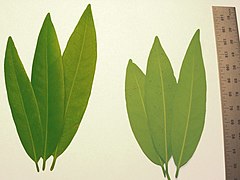Cookbook:Bay Leaf
| Bay Leaf | |
|---|---|
 | |
| Category | Herbs and spices |
Cookbook | Recipes | Ingredients | Spices and herbs
Bay leaves are the aromatic leaves of several species of the laurel family. They are used in cooking for their distinctive flavor and fragrance.
Characteristics[edit | edit source]
Bay leaves are elongated with a pointed tip, and they are fairly sturdy.[1]
The spice has a few compounds that give it its characteristic flavor. The dominant flavor comes from cineole, which has a cooling eucalyptus flavor. It also has clove-like eugenol, and other notes of citrus and pine.[2] When cooking, the most immediate flavors will be of the cooler eucalyptus, while prolonged gradual cooking is required to extract the more warming and subtle flavors.[2][3] The flavors are also more soluble in fat and alcohol, so warming the leaf in oil helps bring them out.[2][3]
Bay leaf is commonly used whole, but it may be ground up to include in spice blends. Note that doing so will make the flavor more pungent due to the increased surface area.[4]
Varieties[edit | edit source]
There are several varieties of bay leaf. Most recipes in English use the term "bay leaf" to mean the Mediterranean bay leaf unless otherwise specified.
Mediterranean bay leaf: from the bay laurel or "true/sweet laurel", Laurus nobilis; often used to flavor soups, stews, and braises and pâtés in French and Mediterranean cuisines.
California bay leaf: from Umbellularia californica, also known as "California laurel", "Oregon myrtle", and "pepperwood"; similar to the Mediterranean bay, but with a much stronger flavor that makes the two not interchangeable.[5]
Indian bay leaf (tej pat): from Cinnamomum tejpata; has three veins running down the leaf; similar in fragrance and taste to cinnamon bark, but milder; culinarily quite different from the other bay leaves.
Indonesian bay leaf (daun salam): dried leaf of Syzygium polyanthum; there is no good substitute for this leaf in cooking.
Selection and storage[edit | edit source]
Unlike some other herbs, the bay leaf is not negatively affected by drying—in fact, this reduces its slight bitterness[2][1]—and it is most available in this form. They should be kept in an airtight container away from light and heat, where the will keep for about a year. To extend their shelf life, they can also be store in the freezer.[3] Expired bay leaves will lose their aromatic characteristics.
If you do get your hands on fresh bay leaves, they can be kept in the freezer. In the United States, fresh bay leaves are usually California bay leaves,[3] so make sure that's the variety you want if purchasing.
Use[edit | edit source]
In French cooking, bay leaf is included in the traditional bouquet garni.[2][1][5] It pairs nicely with warming flavors like clove and cinnamon to season meat—it is used this way in garam masala.[2][6] Using bay leaf in sweet preparations is less common but not unheard of, and it has historically been used to flavor custards.[5]
Gallery[edit | edit source]
-
Mediterranean (sweet) bay leaf
-
California bay leaf
-
Indian bay leaf (tej pata)
-
Indonesian bay leaf (daun salam)
Recipes[edit | edit source]
References[edit | edit source]
- ↑ a b c Labensky, Sarah R.; Hause, Alan M.; Martel, Priscilla (2018-01-18). On Cooking: A Textbook of Culinary Fundamentals. Pearson. ISBN 978-0-13-444190-0.
- ↑ a b c d e f Farrimond, Dr Stuart (2018-11-06). The Science of Spice: Understand Flavor Connections and Revolutionize Your Cooking. National Geographic Books. ISBN 978-1-4654-7557-2.
- ↑ a b c d "What's the Point of Bay Leaves? | Ask The Food Lab". Serious Eats. Retrieved 2023-12-20.
- ↑ "Why Are Bay Leaves Always Used Whole?". Serious Eats. Retrieved 2023-12-20.
- ↑ a b c Davidson, Alan (2014-01-01). Jaine, Tom (ed.). The Oxford Companion to Food. Oxford University Press. doi:10.1093/acref/9780199677337.001.0001. ISBN 978-0-19-967733-7.
- ↑ "Spice Hunting: Bay Leaf, The Herb That Thinks It's A Spice". Serious Eats. Retrieved 2023-12-20.



